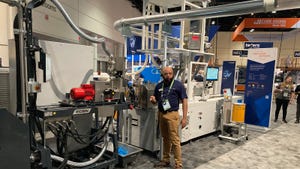Is there—or is there not—a lack of skilled workers?
September 4, 2016

Recently I wrote a blog on a survey showing that the “skills gap” we hear so much about is a myth; that, in reality, there are plenty of workers out there to fill the demand for skilled labor. Besides, if all the manufacturing is moving beyond the U.S. border to Mexico and offshore to China, there should not even be a labor shortage for skilled jobs.
|
Image courtesy TheLeadSA/flickr. |
But it seems there is another side to this story—as there often is—namely that the number of manufacturing job openings has increased since 2009 and “this year stands at the highest level in 15 years,” according to U.S. Labor Department data. We know that investments in advanced machine technology and robotics have reduced the number of workers needed in many manufacturing facilities, which accounts for the fact that productivity has remained relatively high despite a lower human count.
An article appearing in the Sept. 2 edition of the Wall Street Journal, noted that this might account for the fact that there is currently a “mismatch” in today’s manufacturing jobs market, in which the skills in demand are of a higher level than the workers who suffered the loss of their jobs over the past decade. The WSJ article cited one company, Kyocera SGS Precision Tools Inc., which at one time had 550 employees. Today it operates with half that number but realizes twice the productivity “thanks to higher-skilled employees and equipment like CNC machine tools.”
According to the WSJ article, openings for manufacturing jobs this year alone have “averaged 353,000 a month, up from 311,000 in 2015 and 122,000 in 2009. Higher skill requirements mean a higher level of education. The Labor Department says “that in 2000, 53% of manufacturing workers had no education past high school. By 2015, that share had fallen 9 percentage points, while the share with college or graduate degrees increased 8 points” said the WSJ article.
According to a third study on the manufacturing skills gap performed by Deloitte and the Manufacturing Institute, "The Skills Gap in U.S. Manufacturing: 2015 and Beyond," over the next decade, “nearly three and a half million manufacturing jobs likely need to be filled and the skills gap is expected to result in 2 million of those jobs going unfilled.” Two major contributing factors to the widening of this gap is the continued mass retirement of the baby boomer generation and economic expansion.”
Eighty-two percent of executives responding to the Deloitte survey “indicate they believe the skills gap will impact their ability to meet customer demand, and 78% believe it will impact their ability to implement new technologies and increase productivity.” On average, it takes manufacturing employers 70 days to recruit skilled production workers. “Facing these numbers, it comes as no surprise why manufacturers report the most significant business impact of the talent shortage is their ability to meet customer demand,” said Deloitte.
Talent shortages always have the automotive industry worried. Almost every bi-monthly report from the Original Equipment Suppliers Association (OESA) over the past two years has indicated a concern when it comes to finding enough skilled workers to help meet the heavy demand from automotive customers. And automotive OEMs are continually expressing concern that this lack of talent may interfere with their production schedule.
Deloitte and the Manufacturing Institute claim there is a solution to this problem of talent shortage: “Manufacturers should build robust community outreach programs, design curriculums in collaboration with technical and community colleges and continue to invest in external relationships that help attract talent.”
Far from being a myth, the skills gap in manufacturing is real and it is a problem for companies that are trying to grow their businesses, keep their customers’ requirements fulfilled and be profitable. In spite of all the manufacturing and automation technology being implemented, people remain the key ingredient in any successful manufacturing business. Given a labor participation rate that hovers around 62%, and a vast number of young men who do not work and are not even looking for work (read the Sept. 2 WSJ editorial on page A11: “The Idle Army: America’s Unworking Men”), there are many opportunities to hire people who want to work (and this is another issue) and are willing to be trained to do today’s jobs either at a technical school or through apprenticeship programs.
The skills gap is not going away any time soon, and as the types of jobs required may change as the manufacturing landscape changes, the demand for people to fill these jobs will remain.
About the Author(s)
You May Also Like




